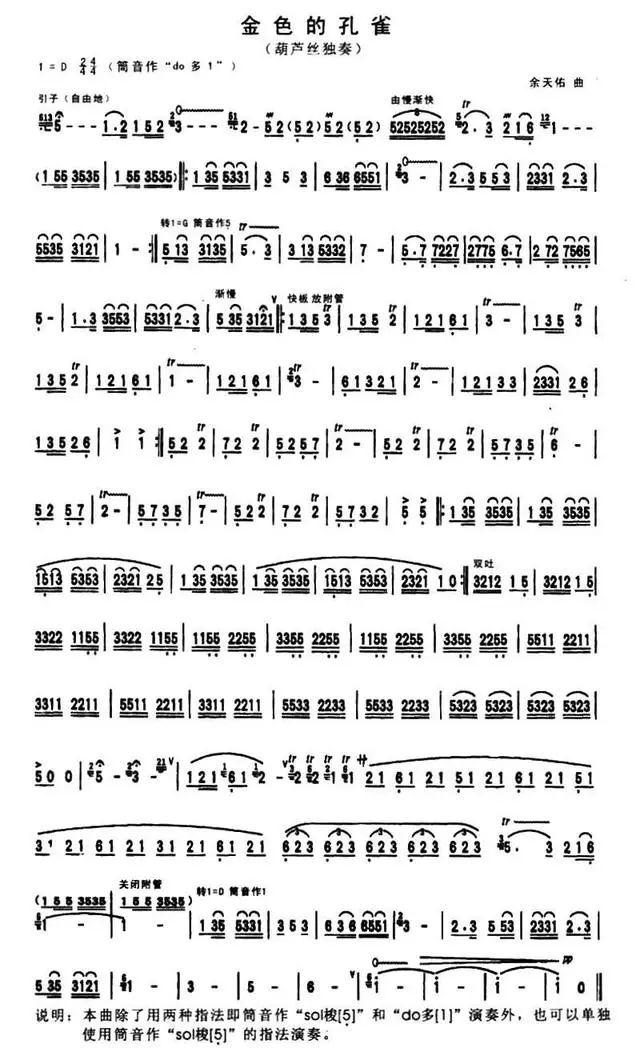Hulusi tune "Golden Peacock" performance explanation
The whole piece is divided into five parts, namely: the introduction, the middle board, the allegro, the middle free phrase, and the epilogue. This piece has a beautiful melody. It has both a Dai music style and a complete musical genre. The expression techniques are extremely rich. Its performance uses two fingerings, 1 and 5, to make the melody more beautiful and the emotional changes more abundant. .
Finally, I will introduce the techniques used in this piece. The more prominent techniques used in this piece are mainly the use of double vomit and vibrato. Since these two techniques are used a lot, the difficulty of the performance increases significantly. But it is the application of these two techniques that makes the allegro of the music more lively, cheerful and inspiring.
Next, I will give you some hints about the places that need to be paid attention to in the performance of this cucurbit flute.
one. performance of the introduction
The introduction is played with the fingering of 1 in full succession. Pay attention to the smoothness of the melody in the performance of the cucurbit flute, especially the performance of the two polyphonic sounds, namely 6135 and 612, and the performance of the Boeing in 52 should be natural and relaxed. The performance of the whole introduction should be stretched and generous. It stretches freely.
two. middle plate part
In this section of the middle board, except that the ninth bar has a more prominent feature of changing the fingering method to 5, the performance of the rest of the bars is not difficult in the early stage. It is necessary to pay attention to the deployment of breath, especially from the seventh bar to the eighth bar. Due to the frequent occurrence of the 5th year of the tube, the consumption of breath also increases, so when the fourth measure is finished, the breath should be deep, and the air flow in the lungs should be increased as much as possible to ensure that the performance is not out of touch, and the breath is continuous to ensure the integrity of the music.
three. Allegro part
In this song, the allegro part is the most difficult, and it is also the most proud of this channel, and it is also the most popular part of the audience. The whole allegro part has a total of 57 bars, of which it is divided into three parts. The first part is from 1 to 32 bars. In this part, the key is to pay attention to the use and performance of vibrato, and also to pay attention to the performance of speed and strength. In addition to speed and melody, another key point to promote emotions in allegro performance is the performance of strength and weakness. When playing to the 17th bar, you can relax a little and make it tight and loose.
The second part is 33-40 bars. In this part of the performance, the midrange jumps more, and the fingers should be very flexible. You can speed up the tempo and be a little more emotional than the first part, so as to better promote the emergence of the musical climax.
The third part is 41-57 bars, which is the climax of the whole piece. Mainly playing with double accents. In fact, the performance of double vomit is not terrible, as long as you practice more, especially the practice of the tongue, in the practice process, practice slowly first, first cooperate with the tongue and fingers, and then slowly increase the speed after a period of practice. You can play easily and control freely.
I think the most difficult of the three parts of Allegro is the breath control. It is required that the performance of bars 41-57 in the Allegro part should be performed in one go without ventilation in the middle. To achieve this, two points must be achieved. First, the speed should be fast. Second, the ventilation between bars 40 and 41 should ensure sufficient air intake. In this way, it can be ensured that it is done in one go, especially when the additional pipe is opened and the requirements are higher. In addition, between bars 41 and 57, you should consciously increase the speed gradually, feel like you are going straight to the top, and stop at the highest point.
Four. Natural beat part
When people's emotions are active to a certain height, they need to adjust, take a breath, slowly relax, and return to peace. In this part, although it is a free tempo and calmed down, the feeling of excitement cannot be eliminated immediately. The vibrato, gradual increase, and the use of triplets make the calm music mixed with a little excitement and impulsiveness. Please pay attention to the regulation of musical mood when playing.
five. epilogue part epilogue
It is carried out on the basis of the medium board music. When the music enters the ending part, the whole music mood really enters into peace. After the excitement, the mood enters into peace with a kind of satisfied joy. When playing this piece, skill and speed are all external work, but what is really internal is the embodiment of its entire musical emotion. Only when the internal performance is well performed can it be considered a good performance of this piece. The emotion of music is musical. soul.

 渝公网安备 50010702504639号
渝公网安备 50010702504639号